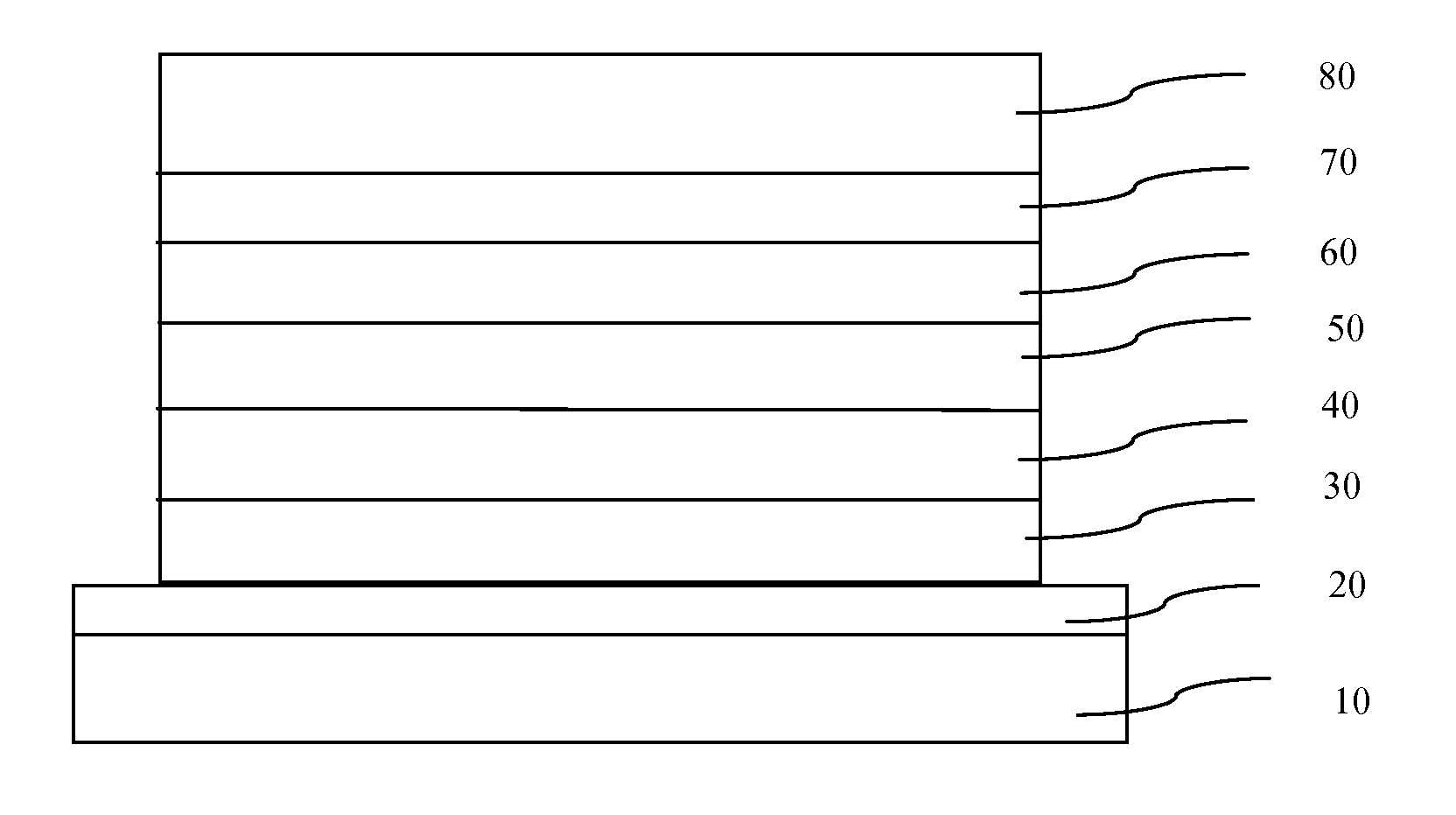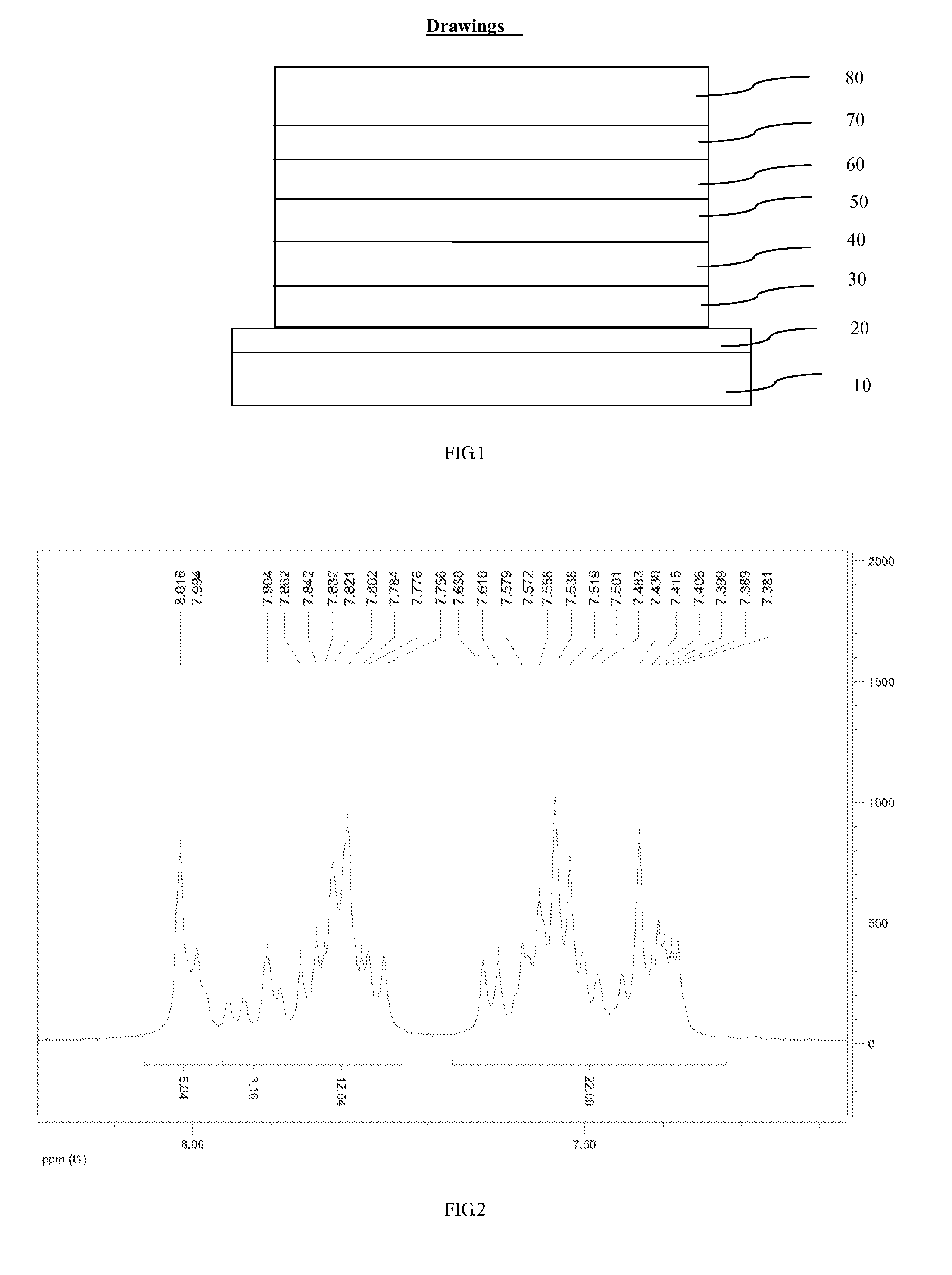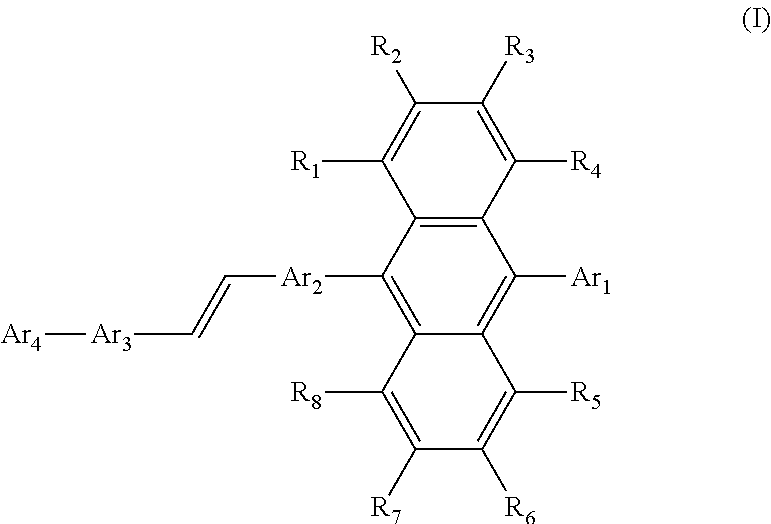Organic electroluminescent device
a technology of electroluminescent devices and organic blues, which is applied in the direction of luminescent compositions, thermoelectric devices, chemistry apparatuses and processes, etc., can solve the problems of limited application of this type of compounds in full-color display devices, poor stability of materials, and inability to widely use, etc., to achieve good light-emitting efficiency, good electron-transport performance, and excellent color purity
- Summary
- Abstract
- Description
- Claims
- Application Information
AI Technical Summary
Benefits of technology
Problems solved by technology
Method used
Image
Examples
embodiment 1
Synthesis of Compound 110
[0032]
Synthesis of Intermediate 1-1
[0033]To a 1 L single-necked flask, was added 25.5 g 1-naphthaleneboronic acid and 25 g bromobenzaldehyde, 400 ml dioxane, 80 ml 2 M potassium carbonate solution, 1.0 g tetrakis(triphenylphosphine)palladium under the protection of nitrogen. The mixture was refluxed for 12 hours, cooled down, and extracted three times with ethyl acetate. The organic phase was dried over anhydrous sodium sulfate, concentrated, and recrystallized from ethanol to yield 29 g solid (92%).
Synthesis of Intermediate 1-3
[0034]To a 500 ml single-neck flask, was added 25 g p-bromobenzyl bromide and 49.8 ml triethyl phosphite (1-2). The mixture was refluxed for 2 hours, then the excess triethyl phosphate was removed. 23.4 g intermediate 1-1, 250 ml DMF, and 16.8 g potassium tert-butoxide were added into the flask in an ice bath. The resulting mixture was allowed to warm to the room temperature, and stirred overnight. The reaction mixture was poured into...
embodiment 2
Synthesis of compound 122
[0040]
Synthesis of Intermediate 2-2
[0041]With the protection of nitrogen, 36.3 g intermediate (2-1) and 400 ml THF were added into a 1 L three-necked flask, which was cooled down to −78° C. followed by adding dropwise 50 ml 2.5M n-butyl lithium and kept stirring for 2 hours. Then 30 g triisopropyl borate was added and the mixture was kept stirring at low temperature for another 1 hour before allowed to warm to room temperature and stirred for another 12 hours. 2N dilute hydrochloric acid was added to neutralize the reaction mixture, which was then extracted three times with ethyl acetate. The organic phase was dried over anhydrous sodium sulfate, concentrated, and recrystallized from ethyl acetate and n-hexane to yield 27 g product (90%).
Synthesis of Intermediate 2-3
[0042]To a 500 ml one-neck flask, was added 25 g intermediate 2-2, 14.5 g 1-bromo-4-iodobenzene, 300 ml dioxane, 60 ml 2M potassium carbonate aqueous solution, 0.6 g tetrakis(triphenylphosphine)p...
embodiment 3
[0045]An illustrative preparation process of blue OLED adopting the organic electronic material in the present invention is given as below.
[0046]Firstly, the transparent glass substrate 10 (with conductive ITO as anode 20 above) was washed with detergent solution, deionized water, ethanol, acetone, deionized water in sequence, then treated with oxygen plasma for 30 seconds, and then treated with CFx plasma.[0047]A 5 nm-thick film of MoO3 was evaporated on top of ITO, which is used as the hole injection layer 30.[0048]A 50 nm-thick film of P1 was evaporated as the hole transport layer 40.[0049]A 20 nm-thick film of compound 110 was evaporated above the hole transport layer as the light emitting layer 50.[0050]A 40 nm-thick film of P2 was evaporated above the light emitting layer as the electron transport layer 60.[0051]Finally, a 1.2 nm-thick LiF film was evaporated as the electron injection layer 70, and a 150 nm-thick Al film was evaporated as the device cathode 80.
[0052]The device...
PUM
| Property | Measurement | Unit |
|---|---|---|
| emission wavelength | aaaaa | aaaaa |
| thickness | aaaaa | aaaaa |
| thickness | aaaaa | aaaaa |
Abstract
Description
Claims
Application Information
 Login to View More
Login to View More - R&D
- Intellectual Property
- Life Sciences
- Materials
- Tech Scout
- Unparalleled Data Quality
- Higher Quality Content
- 60% Fewer Hallucinations
Browse by: Latest US Patents, China's latest patents, Technical Efficacy Thesaurus, Application Domain, Technology Topic, Popular Technical Reports.
© 2025 PatSnap. All rights reserved.Legal|Privacy policy|Modern Slavery Act Transparency Statement|Sitemap|About US| Contact US: help@patsnap.com



